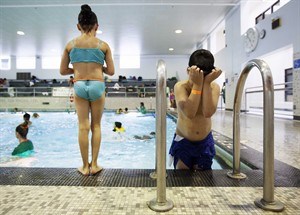
A child wipes his eyes as he climbs out of a pool in Toronto on Friday, August 10, 2012. Public pools help with summer swelter, but swimmers should beware of infections. THE CANADIAN PRESS/Michelle Siu
August 13, 2012 - 7:00 AM
TORONTO - Growing up as a competitive swimmer in Halifax, Leslie Oland came home from the pool one day to find an unpleasant surprise.
A number of itchy bumps had broken out on her armpit. A doctor eventually told her it was molluscum contagiosum, an infection picked up from skin-to-skin contact with an infected person or infected surfaces. She's convinced she caught it from her time in public pools.
"I was at the pool all the time. And now, when I look at how you catch it, it's dirty towels or damp towels, which are things you would have around the pool."
Turns out going for a swim may not always be as sexy as it seems.
The bumps were about the size of a baby's fingernail, and ultimately left Oland with pock marks similar to the aftermath of chicken pox.
While many Canadians have turned to public pools this summer seeking relief from sweltering temperatures, experts say steps can be taken to prevent pool-related maladies like athlete's foot and plantar warts, as well as gastrointestinal infections that spread through exposure to bacteria.
Responsibility for disease prevention, they say, lies both with those who maintain pools as well as with swimmers themselves.
Shelley Beaudet, a senior environmental health officer with Vancouver Coastal Health, says two of the biggest pool-related ailments are infection by cryptosporidium and pseudomonas. Cryptosporidium is spread when those with gastrointestinal problems like diarrhea use a pool. Pseudomonas, meanwhile, is a germ commonly found in water or soil, and can cause a rash for those who swim in infected water.
Both cryptosporidium and pseudomonas are resistant to chlorine.
Beaudet says those with gastrointestinal problems should simply stay out of the pool. And pseudomonas can best be avoided by making sure the area surrounding the pool is kept sanitized.
Those using hot tubs should keep their eyes peeled for greasy-looking bubbles on top of the water, a sure sign of unsanitary conditions.
"Scrub the edges of the pool, anywhere there's a greasy, slimy layer," said Beaudet. "Keep chlorine levels accurate and up to standards, and be careful about how you're adding water."
She says it's important to add fresh water often, and to avoid leaving the end of a hose on the ground where it can attract bacteria.
In Toronto, there's quite a bit of this sort of maintenance to be done. The city operates 63 indoor pools that draw 2.5 million visits per year, and 59 outdoor pools that bring in 1.3 million visits in the summer months alone.
Mahesh Patel is a manager with the healthy environments sector of Toronto Public Health. He says that while Toronto's public pools are well maintained, it is possible to pick up an infection in any body of water.
The key to avoiding those infections, Patel says, is personal hygiene.
"If you have a cut or any kind of infection, don't go in the pool so you don't spread infections."
Basic washing before getting in the pool is important, too.
"Everyone who enters a pool should take a shower with soap and water. That will remove any sweat, any contaminants on the body before you enter the pool water. When you're clean and you go into the pool, it doesn't use up the chlorine, so it protects where it needs to protect."
Dr. Allison McGeer is the director of infection control at Toronto's Mount Sinai hospital. A 23-year veteran of her field, she says that although it is possible to pick up infections at public pools, they're mostly safe places to go and have fun.
"Probably the biggest risk is athlete's foot from the showers. Generally speaking, public pools are sufficiently carefully maintained, that your chances of getting an infection in a public pool are slim to none," she said.
Most of the risks and outbreaks she's seen recently come from parks with wading pools that incorporate spraying water. These can act as breeding grounds for bacteria due to the high volume of children in diapers.
Children in diapers, she said, should avoid public swimming pools.
An accident, after all, would likely cause the pool to be evacuated while maintenance workers deal with the problem by checking filters and adding chlorine. On a hot day, that's not a desirable outcome.
"It's about reading the rules and understanding that the reason public health people have rules about diapered children and illness and other things is that those rules are important to protect everybody who is using the pools," said McGeer.
"We have rules that say if you have diarrhea or your kid has diarrhea, you don't bring them into the pool. Generally, Canadians are good people and careful about that, and they don't break public health rules that are there for good reason."
In order to avoid plantar warts and athlete's foot, McGeer says the best thing to do is simply wear flip flops and make sure feet are thoroughly dried after getting out of the pool.
For Oland's part, developing molluscum contagiosum didn't scare her from using the pool.
But she does make a point of wearing flip-flops, and she is possessive of her towel.
News from © The Canadian Press, 2012